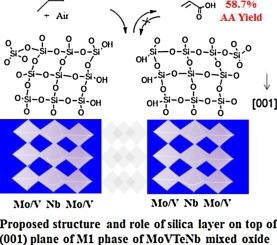Applied Catalysis A: General ( IF 4.7 ) Pub Date : 2017-09-10 , DOI: 10.1016/j.apcata.2017.09.013 Xinlin Tu , Masao Niwa , Akio Arano , Yoshinori Kimata , Eiichi Okazaki , Souichi Nomura

|
Acrylic acid is an important industrial chemical, and efficient catalysts for its direct preparation by propane oxidation are highly desirable. For this purpose, neutral silica networks were introduced on the surface of MoVTeNb mixed oxide catalysts by controlled silylation using a methyl silicate oligomer (MS-51). The modified catalysts gave ∼56.5% yield of acrylic acid with a selectivity of 77.1% in the oxidation of propane at 380 °C. The catalysts were characterized by X-ray fluorescence, Fourier-transform infrared spectroscopy, Brunauer–Emmett–Teller specific surface area, X-ray diffraction (Rietveld analysis), pyridine desorption, and scanning electron microscopy. MoVTeNb mixed oxide was found to be composed of 90.9% M1 phase and 2.3% M2 phase, and upon silylation, the surface was uniformly covered by a thin SiO2 layer with 0.14 molar ratio with respect to Mo and an estimated thickness of 2.4 nm. The amount of acid sites decreased after the first three silylation cycles, but was not affected by repeated cycles. The results of the kinetic study based on the comparison of the simulated contribution of each side reaction were consistent with those of the model reactions using acrylic acid and other reactants: the controlled silylation effectively suppressed acrylic acid oxidation, especially after repeated silylation cycles, which is responsible for the superior performance of the silylated catalysts. Considering the relatively large size of acrylic acid compared to propane and the efficient propane activation by silica-covered catalysts, the controlled silylation was proposed to have two roles, by which further consecutive oxidation is prevented effectively to exhibit excellent performance in oxidation of propane: i) to block the unfavorable acidic sides, ii) to generate a silica layer with pore mouth openings on the surface of MoVTeNb mixed oxide, which allow the entrance of propane but inhibit re-entrance of the produced acrylic acid.
中文翻译:

MoVTeNb混合氧化物催化剂的可控硅化反应,可将丙烷选择性氧化为丙烯酸
丙烯酸是一种重要的工业化学物质,非常需要用于通过丙烷氧化直接制备的有效催化剂。为此,通过使用甲基硅酸盐低聚物(MS-51)进行可控制的甲硅烷基化,将中性二氧化硅网络引入MoVTeNb混合氧化物催化剂的表面。改性的催化剂在380℃丙烷的氧化中得到〜56.5%的丙烯酸收率,选择性为77.1%。通过X射线荧光,傅里叶变换红外光谱,Brunauer-Emmett-Teller比表面积,X射线衍射(Rietveld分析),吡啶解吸和扫描电子显微镜对催化剂进行了表征。发现MoVTeNb混合氧化物由90.9%的M1相和2.3%的M2相组成,并且在甲硅烷基化后,表面被薄的SiO 2均匀覆盖。相对于Mo的摩尔比为0.14且估计的厚度为2.4nm的有机层。在前三个甲硅烷基化循环后,酸位点的数量减少,但不受重复循环的影响。通过比较每个副反应的模拟贡献进行的动力学研究结果与使用丙烯酸和其他反应物的模型反应的结果一致:受控的甲硅烷基化有效抑制了丙烯酸的氧化,特别是在重复的甲硅烷基化循环后,这是负责硅烷化催化剂的优异性能。考虑到与丙烷相比,丙烯酸的尺寸相对较大,并且二氧化硅覆盖的催化剂可以有效地活化丙烷,因此提出了可控制的甲硅烷基化具有两个作用,











































 京公网安备 11010802027423号
京公网安备 11010802027423号